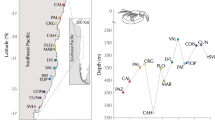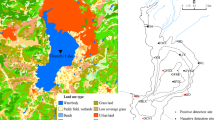Abstract
This study reports the distribution, estimated abundance and biomass, and genetic population structure of the red crab Pleuroncodes planipes along the western coast of the Baja California Peninsula, Mexico. Using a hybrid conical net for fish and crustaceans, bottom trawls with stratified depth were performed at transect sites perpendicular to the coast. Red crab was observed to distribute widely in the study area, particularly in upwelling areas such as Bahia Magdalena and its surroundings, and the greatest catches were recorded at depths between 51 and 100 m, and between 201 and 300 m, with values of 2,297 and 3,223 kg/h of trawl, respectively. The population genetic analysis using mitochondrial DNA sequencing revealed no significant population differentiation. The total estimated biomass was 611,525 metric tons, supporting the proposal that the red crab is a viable exploitation resource in the study area.




Similar content being viewed by others
References
Caddy JF, Rodhouse PG (1998) Cephalopod and groundfish landings: evidence for ecological change in global fisheries. Rev Fish Biol Fish 8:431–444
Allendorf F, Ryman N (1987) Genetic management of hatchery stocks. In: Ryman N, Utter F (eds) Population Genetics and Fishery Management. Washington University Press, Seattle, pp 141–160
FAO (1993) Report of the expert consultation on utilization and conservation of aquatic genetic resources. FAO Fish Rep 491:1–58
Beklemishev KV (1960) The hidden cause behind the accumulation of crustacean along the shores of Mexico. Priroda 2:97–98
Ehrhardt NM, Ramírez E, Aguilera P, Jacquemin P, Lozano M, Romo I (1982) Evaluation of demersal resources accessible to bottom trawl nets in the continental shelf of the west coast of the Baja California Peninsula, Mexico, during 1979 and 1980. Natl Fish Inst Sci Ser 23:10–46 (in Spanish)
Aurioles-Gamboa D (1995) Distribution and abundance of benthic red crab Pleuroncodes planipes in the continental shelf of the west coast of the Baja California Peninsula. In: Aurioles-Gamboa D, Balart EF (eds) The red crab: biology, ecology, and exploitation. Northwest Biological Research Center, La Paz, pp 59–78 (in Spanish)
Díaz-Uribe JG (2006) Red crab of the Pacific Ocean. In: Arreguín-Sánchez F, Balart EF et al (eds) Sustainability and responsible fishing in Mexico, evaluation and management. National Fisheries Institute, Mexico, pp 213–218 (in Spanish)
Gómez-Gutiérrez J, Sánchez-Ortíz CA (1995) Hatching and larval and postlarval drift centers of the red crab Pleuroncodes planipes (Crustacea: Galatheidae), in the western coast of Baja California Sur. In: Aurioles-Gamboa D, Balart EF (eds) The red crab: biology, ecology, and exploitation. Northwest Biological Research Center, La Paz, pp 35–57 (in Spanish)
Arvizu-Martínez J, García-Romero E, Morales-Alemán I (1974) Preliminary study on red crab, Pleuroncodes planipes Stimpson (Crustacea; Galatheidae), of the western coast of Baja California and Gulf of California. Natl Fish Inst Sci Ser 1:1–10 (in Spanish)
Aurioles-Gamboa D (1995) Bathymetric migration of the benthic red crab in the continental shelf of the Pacific of Baja California Sur. In: Aurioles-Gamboa D, Balart EF (eds) The red crab: biology, ecology, and exploitation. Northwest Biological Research Center, La Paz, pp 79–92 (in Spanish)
Chu KH, Li CP, Tam YK, Lavery S (2003) Application of mitochondrial control region in population genetic studies of the shrimp Penaeus. Mol Ecol Notes 3:120–122
Fogarty MJ (1985) Statistical considerations in the design of trawl surveys. FAO Fish Circ 786:1–21
Sparre P, Ursin E, Venema SC (1989) Introduction to tropical fish stock assessment. Part 1-Manual. FAO Fisheries Technical Paper 306/1 Rome, FAO, p 337
Perez-Enriquez R, Garcia-Rodriguez FJ, Mendoza-Carrion G, Padilla C (2011) Geographical variation in the genetic diversity and composition of the endangered Queen Conch Strombus gigas (Mesogastropoda: Strombidae) from Yucatan, México. Rev Biol Trop 59:1115–1126
Kumar S, Tamura K, Nei M (2004) MEGA3: integrated software for molecular evolutionary genetics analysis and sequence alignment. Brief Bioinform 5:150–163
Rozas J, Sánchez-DelBarrio JC, Messeguer X, Rozas R (2003) DnaSP, DNA polymorphism analyses by the coalescent and other methods. Bioinform 19:2496–2497
Excoffier L, Laval G, Schneider S (2005) Arlequin ver. 3.0: an integrated software package for population genetics data analysis. Evol Bioinform Online 1:47–50
McElroy D, Moran P, Bermingham E, Kornfield I (1991) REAP: an integrated environment for the manipulation and phylogenetic analysis of restriction data. J Hered 83:157–158
Hilborn R, Walters CJ (1992) Quantitative fisheries stock assessment: choice, dynamics and uncertainty. Chapman and Hall, New York
deYoung B, Rose GA (1993) On recruitment and distribution of Atlantic cod (Gadus monhua) of Newfoundland. Can J Fish Aquat Sci 50:2729–2741
Boyd CM (1962) Distribution, trophic relationships, growth, and respiration of a marine decapod crustacean Pleuroncodes planipes Stimpson, 1860 (Galatheidae). PhD dissertation, University of California, San Diego, California, USA
Chávez H, Ramos-Padilla R (1974) Report of the exploratory fishing activities aboard the vessel “Louis Caubriere”, in national waters of the Pacific, during 1968 and 1969. National Fisheries Institute/SI:i22, Mexico, pp 1–32 (in Spanish)
Schulz H (1976) Results of the “MEXAL” program: Pleuroncodes planipes (Stimpson), the bottom trawl catches of the Research Vessels “Bonn” and “Wesser”. Bundesforschungsanstalt für Fischerei, Institut für Seefischerei, Hamburg, pp 1–4
Bakun A, McLain DR, Mayo FV (1974) The mean annual cycle of coastal upwelling off western North America as observed from surface measurements. Fish Bull 72:843–844
Bakun A, Nelson CS (1977) Climatology of upwelling related processes off Baja California. Calif Coop Oceanic Fish Invest Rep 19:107–127
Parker H (1996) Interannual variability in the PFEG coastal upwelling indices. In: Isaacs CM, Tharp VL (eds) Proceedings of the 12th Annual Pacific Climate (PACLIM) Workshop, Interagency Ecological Studies Program for the Sacramento-San Joaquin Estuary. IEPSSE Tech Rep 46:63–99
Robinson CJ, Anislado V, Ramos P (2004) Shoaling fish and red crab behaviour related to tidal variations in Bahía Magdalena, México. Deep Sea Res PT II 51:767–783
Boyd CM (1967) Benthic and pelagic habitats of the red crab Pleuroncodes planipes. Pacific Sci 21:394–403
Parker RH (1964) Zoogeography and ecology of some macroinvertebrates, particularly mollusks, in the Gulf of California and the continental slope off Mexico. Vidensk Meddr Dansk Naturn Foren 126(1):178
Longhurst AR (1967) The biology of mass occurrences of galatheid crustaceans and their utilization as a fisheries resources. In: Proceedings of the World Scientific Conference on the Biology and Culture of Shrimps and Prawns. FAO Fish Rep 57:95–110
Blackburn M, Thorne RE (1974) Composition, biomass and distribution of pelagic nekton in a coastal upwelling area off Baja California, Mexico. Tethys 6:281–290
Hernández-Llamas A, Balart EF, Ponce-Díaz G, Civera-Cerecedo R (2006) Feasibility of a new fishery in Baja California, Mexico based on the red crab Pleuroncodes planipes: preliminary economic evaluation and risk assessment. Aquat Living Resour 19:173–179
Arana EP (1993) Resurgence of the red crab. Revista Chile Pesquero 70:29–33 (in Spanish)
Roa R, Bahamonde R (1993) Growth and expansion of an exploited population of the squat lobster (Pleuroncodes monodon) after 3 years without harvesting. Fish Res 18:305–319
Achurra ML (1988) New increase of the fishing exports in 1987. Revista Chile Pesquero, May-June 19–22 (in Spanish)
Balart EF (1996) The red crab resource. In: Casas-Valdez M, Ponce-Diaz G (eds) Study of the fishing and aquaculture potential of Baja California Sur, vol 1. Northwest Biological Research Center, La Paz, pp 167–180 (in Spanish)
Aurioles-Gamboa D, Balart EF, Castro-Aguirre JL (1995) Recommendations for the exploitation and use of the red crab. In: Aurioles-Gamboa D, Balart EF (eds) The red crab: biology, ecology, and exploitation. Northwest Biological Research Center, La Paz, pp 221–233 (in Spanish)
Avise JC (2000) Phylogeography: the history and formation of species. Harvard University Press, Cambridge
Gómez-Gutierrez J, Dominguez-Hernandez E, Robinson CJ, Arenas V (2000) Hydroacoustical evidence of autumn inshore residence of the pelagic red crab Pleuroncodes planipes at Punta Eugenia, Baja California, Mexico. Mar Ecol Prog Ser 208:283–291
Bernardi G, Talley D (2000) Genetic evidence for limited dispersal in the coastal California killifish, Fundulus parvipinnis. J Exp Mar Biol 255:187–199
García-Rodríguez FJ, Pérez-Enríquez R (2006) Genetic differentiation of the California spiny lobster Panulirus interruptus (Randall, 1840) along the west coast of the Baja California Peninsula, Mexico. Mar Biol 148:621–629
Acknowledgments
The Secretaría de Agricultura, Ganadería, Desarrollo Rural, Pesca y Alimentación (SAGARPA) and Consejo Nacional de Ciencia y Tecnología (CONACYT) provided funding (grant 2003-002-019 to the first author). The authors thank Gabriel Rivera Velázquez and the crew of the R/V “BIP XII” for their support during the cruise. Thanks are also due to Gemma Louise Franklin and Tania Zenteno-Savín for translating and editing the English language. Three anonymous reviewers helped to improve the manuscript.
Author information
Authors and Affiliations
Corresponding author
Rights and permissions
About this article
Cite this article
De Anda-Montañez, J.A., Perez-Enriquez, R., Martínez-Aguilar, S. et al. Abundance and genetic diversity of the red crab Pleuroncodes planipes along the western coast of the Baja California Peninsula, Mexico. Fish Sci 79, 21–32 (2013). https://doi.org/10.1007/s12562-012-0574-5
Received:
Accepted:
Published:
Issue Date:
DOI: https://doi.org/10.1007/s12562-012-0574-5




